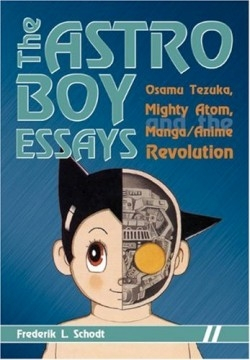The Astro Boy Essays
Osamu, Tezuka, Mighty Atom, Manga/Anime Revolution
The United States has been feeling the profound effects of Japan’s cultural influence over the last decade. This influence can be traced back through several different pop cultural icons such as martial arts, monsters (Godzilla), anime, and most recently, manga. Schodt takes a shot at exploring the worldwide influence of manga and anime through the character known as Astro Boy in the United States, but originally named Mighty Atom in Japan. Created by Tezuka Osamu, the “God of Manga” in the early 1960s, this robot boy became a national icon in Japan by the end of the decade appearing in magazines, the first animated television show, bound collections of comic strips, and of course, merchandise. His show even appeared on televisions in the United States for several seasons.
The author of several books on Japanese culture, Schodt is particularly qualified in writing this book, having met and conversed with the deceased Osamu. Schodt explores Osamu and one of his earliest commercial successes, providing readers with an in-depth look at the man and how he conceptualized, created, loved, and hated the series in all its different manifestations. He provides the socio-cultural historical context on how Osamu came to create The Mighty Atom and why the lad caught on so quickly in Japan. Schodt explains the post-World War II Japan culture, which creates better understanding for the country, the artist, and the art.
In his essays, Schodt approaches Osamu and his creation from a variety of angles, examining the world he created and the intertextuality of the various incarnations of the Mighty Atom. In one piece, he tries to reconcile Osamu’s intent and reason for creating the Mighty Atom with the way the character was received, and Osamu’s resulting frustration.
The neophyte to sequential art, or even Japanese culture, will find that Schodt should have included a brief history of manga and animation in Japan in which to better conceptualize Osamu’s role. He provides snippets of this throughout, but the full picture remains elusive.
Sixteen full-page color pictures accompany this book, depicting various covers and excerpts from the series. Speckled throughout, Schodt also includes pictures of Osamu, the Mighty Atom, and stills from the cartoon. His appendices include listings of Osamu’s manga series and television episodes, in both English and Japanese with release dates and TV ratings.
While one can appreciate this book never having seen or read the Mighty Atom, readers may find themselves seeking out the material, if only to better position Schodt’s points. Regardless, he succeeds in this synthesis of pop culture, biography, and history.
Reviewed by
Lance Eaton
Disclosure: This article is not an endorsement, but a review. The publisher of this book provided free copies of the book to have their book reviewed by a professional reviewer. No fee was paid by the publisher for this review. Foreword Reviews only recommends books that we love. Foreword Magazine, Inc. is disclosing this in accordance with the Federal Trade Commission’s 16 CFR, Part 255.

